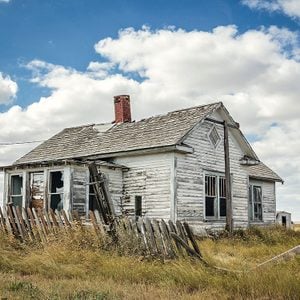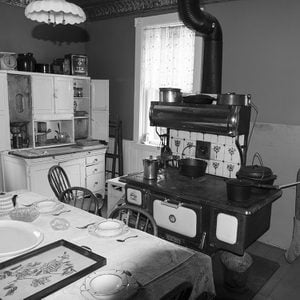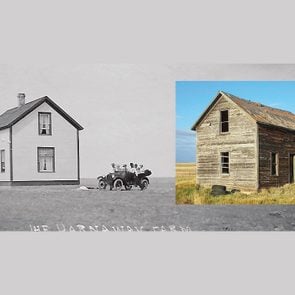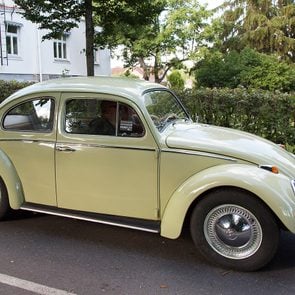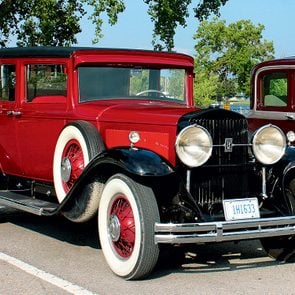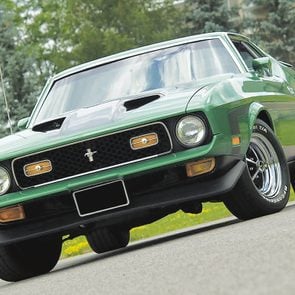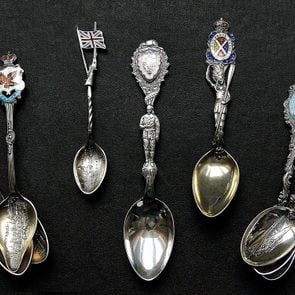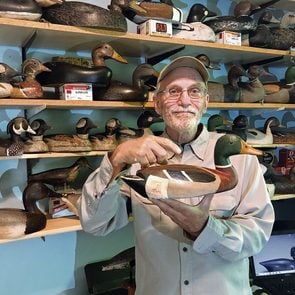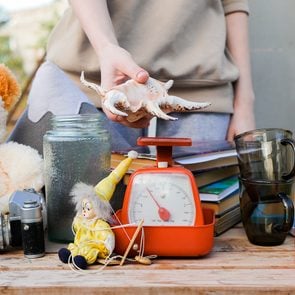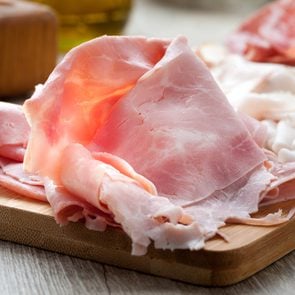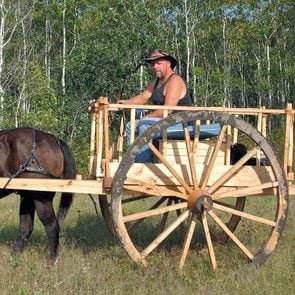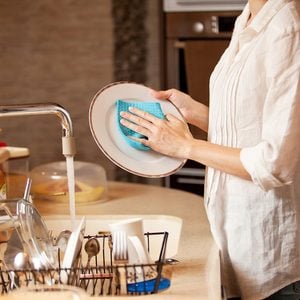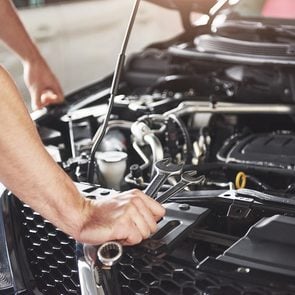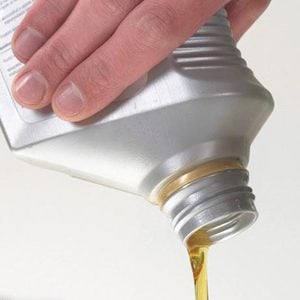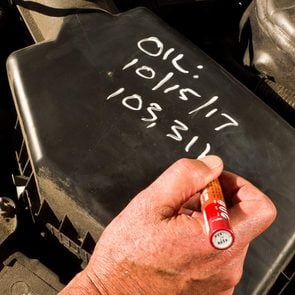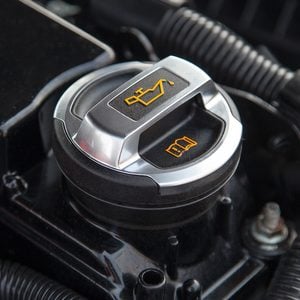
Exploring the old homestead
The old homestead is a small simple structure, made of logs that have been roughly squared off. The cracks are filled in with mud, held in place by a diagonal pattern of dried twigs. There are a few small windows and an open doorway on one side. The door itself is long gone. The home has a peaked roof covered in wooden slats above an attic space which is reached by a wooden ladder, attached to the wall, through a small opening.
The inside space is not much more than about 80-100 square feet, although I have never actually taken the time to measure it. The dirt floor is now covered in layers of cow dung as, over the past 40 years or so, it was often used as a shelter for those animals. Barn swallows have also made use of this structure as a place to build their nests.

But who built it?
However, it was originally a homestead for what I assume were the first people of European descent to occupy this land. I don’t know who lived on this land in the more distant past. The Chipewyan, Chipewyan Prairie Dene, Fort McKay, and Mikisew Cree First Nations were the peoples who occupied this territory near Athabasca for millennia. But I do not know which of them occupied this piece of land. In fact, I know nothing of any of the people who lived there before my parents bought the farm more than 40 years ago.
This old homestead occupies a scenic position overlooking the Tawatinaw Valley, as does my parents’ home several hundred yards away. The view of the homestead is now largely obscured by the pine trees my father planted in the yard many years ago.
Each time I visit the farm, I photograph this old homestead, capturing the changes as well as the different seasons. It provides me with a connection to the past.

Times change
I have never been part of the vintage-style photographs that Dad and his partner Anna-Mae have taken with my nephew, Stephen, his sister, Jessica, and her friend, Katie, where they are standing in the doorway of this old log cabin. My dad and Stephen are dressed in denim overalls with pitchforks in hand. The women are dressed in dowdy looking dresses or skirts and blouses. Each of them has a dour expression on their faces. My father looks especially stern.
Apparently people didn’t smile in old photographs because the exposure was so long, they had to stand rigid lest the photograph turn out blurry. Some photographers even had a kind of head brace for their studio portraits in which they locked people to keep them still. The discomfort would be another reason not to smile. The sepia tone Anna-Mae added to those photos makes them look truly vintage, except that, of course, I know the people in them.
There is another old homestead on another part of the farm, but it is just a blocky looking structure and lacks the charm of this one, as well as the view. One thing it does have in common is the cow dung.
When Stephen was quite young, he and I were visiting the farm at the same time one summer and we took a walk around the farm. As we looked into the old log cabin, he commented how small it was. “That’s true,” I said, “but homes were extremely small at that time. For one thing, they would have been hard to heat.”
“Then where did they put the television set?” my young nephew asked.
“Oh, they certainly didn’t have television back then.”
“What?” he cried incredulously, “everyone should have a TV and a Nintendo game.”
I have no idea what those original occupants did for fun, or if they even had time for any. But I know it was not binge-watching Netflix or playing video games. Those people are long gone. Perhaps they moved into Athabasca or one of the small villages in the area. Perhaps they are buried in one of the local cemeteries, or for all we know, buried somewhere on the farm.
But wherever they or their descendants might be, they have left behind this landmark which for me is still one of the most striking features of the farm.
Next, check out a hundred-year-old mail-order house that’s still standing.
My first car was a 1931 Chevy Berline. I drove it for quite some time and eventually sold it to my brother-in-law, Wes, in the mid-1970s. He stripped it down, painted the frame, and then built the car back up again, fixing what needed fixing along the way, from the springs to the windows.
Years later, he had a triple bypass heart surgery and decided to sell the car to some guy for $5,000 or $6,000. I reminded him that the old Chevy Berline had been my very first car—I had even passed my driver’s test in it—and would rather keep it in the family, if at all possible. So, I offered him $10,000 for it, which he accepted.
This was several years ago, and since then, two friends of mine, Tom and Mike, have done a lot of work on the car, including running new wiring; adding turn signals; refurbishing the roof; and prepping, priming and painting the body a sharp-looking black. They did the majority of the work, with me helping out wherever I could; for example, I repainted the wheel rims and spokes a bright red, the colour they had sported when I first owned the car as a young man of 15.
There’s still work to do, but even so, several people have expressed interest in the car. Now that I have her back, though, I won’t be letting go of her anytime soon!
Next, read the incredible story of how one man missed out on his dream car as a teenager, then found it parked in his driveway 25 years later.

My Blue Mountain Pottery Collection
Since the early 1990s, I’ve enjoyed collecting pieces from the Blue Mountain Pottery company. Named after a popular ski hill in the area, Blue Mountain first opened for business in 1947 in Collingwood, Ontario, near Georgian Bay. Unfortunately, in 2004, the company ceased all operations. They made a unique variety of pottery, including bowls, jugs, vases, tea sets, animals, birds and even sea creatures. My 75-piece collection is mostly in green-streaked hues, but the company also made items in blue, black, gold, brown or red. Each piece is one-of-a-kind!
Many a bride and groom in the 1960s and ’70s would receive Blue Mountain pottery as a wedding present. Two of my older sisters, Jeanette and Lilian, were the recipients of such gifts. Possibly, this was what spurred my interest in collecting it, along with the fact that our family had toured the fascinating Collingwood factory many years ago.
How to Spot Genuine Blue Mountain Pottery
As a collector, you need to be very conscious of some replica Blue Mountain Pottery items. It’s authentic if it has their initials “BMP Canada” and three triangle trees embossed on the bottom. It could also have a blue-and-white tag affixed by string or a rounded sticker, which is also blue-and-white. It’s best to leave these decals on for authenticity.
My entire collection has come from visiting local antique markets and thrift stores. The items I cherish most are a spirited horse, a soaring eagle, fierce lions (above) and a full tea set.
My Blue Mountain Pottery collection is stored in five transparent containers. Each lid has a sheet attached on top listing all the items inside. I also like to display items of my collection in our home, so I will often unwrap some and put others away.
Blue Mountain pieces can range from $10 for a small one to $40 and up for a large piece. If you happen to own some Blue Mountain pottery, hold onto it—its beauty alone is worth treasuring.
Now that you know the Blue Mountain Pottery story, check out this charming collection of vintage teacups.

Cat Jokes For When You’re Just Kitten Around
Optimists: The glass is half full.
Pessimists: The glass is half empty.
Cat owners: The glass is knocked over.
—@OhNoSheTwitnt
Q: How do French cats say “Thank You”?
A: Meow-ci Beaucoup
—Buzzfeed.com
Q: Why are cats so good at video games?
A: They have nine lives.
—@stobywan
Q: If lights run on electricity and cars run on gas, what do cats run on?
A: Their paws.
—Reddit.com
I saw a poster today that asked, “Have you seen my cat?”
So, I called the number and said that I didn’t. I like to help where I can.
—@NorthernOvation
Q: Why are kittens actually excellent bosses?
A: They have great littership.
—Parade.com
Don’t miss our roundup of the best cat videos on YouTube.

Claw-Enforcement
Q: What do you call the cat that was caught by the police?
A: The purr-petrator.
—Reddit.com
I used to be in a band called “Missing Cat”… You probably saw our posters.
—Stewart Francis, comedian
Q: What do you call a feline with a short haircut?
A: A bob cat, of course
—Buzzfeed.com
Q: What do polite cats say when they’re in the way?
A: “Paw-don me! I’m furry sorry.”
—Buzzfeed.com
Q: What’s a cat’s favourite TV show?
A: Claw and Order
—Parade.com
Here are 25 knock-knock jokes that are genuinely hilarious!
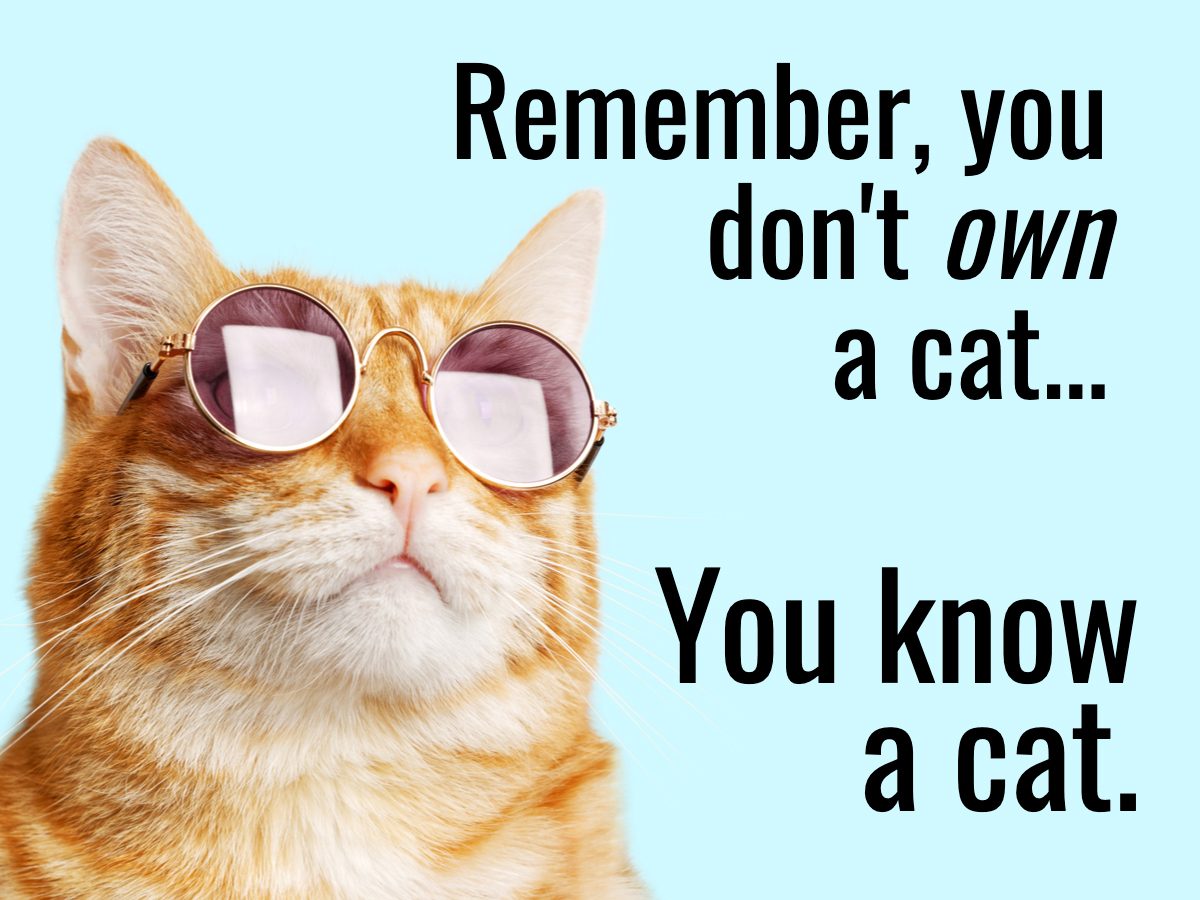
Major Cattitude
Cats are more like “Hey, what are you up to? Never mind—I just remembered I don’t care.”
—Zoltan Kaszas, comedian
Me: *Sobbing* One minute he loves me and the next he wants nothing to do me!
Therapist: That’s pretty typical cat behaviour
—@PetiteRainCity
Q: What animals can you not trust?
A: Big cats! Because some are cheetahs, and some are always lion!
—@RealEllieMay
Remember, you don’t OWN a cat.
You know a cat.
—@shanselman
Q: Why did the cat wear a top hat?
A: Beclaws he was feline sassy
—Buzzfeed.com
Q: What do you call it when a cat is super-stylish?
A: Haute-cat-ture.
—@petassure
Q: Why did the cat avoid eating lemons?
A: They made him a sour-puss.
—Parade.com
My cat loves me so much that sometimes he stares at me with that look of love that’s almost creepy.
—Debra DiGiovanni, comedian
Check out the funniest jokes from 50 Canadian comedians.

Cat Jokes That Will Give You Paws
A fun part of having a black cat is occasionally accidentally talking to a crumpled up black T-shirt on the floor.
—@SarahCAndersen
I make a lot of jokes about my cat, but I always think, wouldn’t it be fun if my cat was making jokes about me to his cat friends? That would be awesome if my cat was at home going, “What’s the deal with all the crying”?
—Debra DiGiovanni, comedian
My husband is in the other room explaining to the cat that even though we are going to bed early, he (the cat) is welcome to stay up.
—@NikkiReimer
Somewhere there is a house cat that did more than I did today.
—Kristeen von Hagen, comedian
Q: What do cats like to eat for breakfast?
A: Mice Krispies.
—Reddit.com
Q: What’s a kitten’s favourite kind of sticker?
A: Scratch and sniff!
—@utacampuscats
If our cat jokes gave you a giggle, don’t miss these hilarious cat GIFs for every occasion!
Jarred condiments
Spreads and sauces may seem to last forever, but they are often exposed to bacteria, putting you at risk of food poisoning. Bacteria can start multiplying as soon as you open a jarred condiment, especially if there happens to be cross-contamination. “When we make sandwiches, for example, we dip the knife into the spread container, wipe it onto the sandwich and then dip it back into the container,” says Jessica Crandall, a Denver-based registered dietitian, certified diabetes educator and national spokesperson for the Academy of Nutrition and Dietetics. “By doing this, you’re putting some bacteria back into the container.” Also, if there’s water floating on top or discolouration, get rid of the whole jar.
Eggs and egg substitutes
Whole raw eggs can stay in the fridge for three to five weeks. An egg substitute will last approximately 10 days after you buy it or three to five days after you open the carton, depending on the expiration date. Keep it any longer and you run the risk of making yourself sick. (Find out 20 foods you’re spoiling by storing in the fridge.)
Cheese
Semi-hard cheeses, such as cheddar and Gouda, have less moisture for bacteria to thrive in, so they can last two to four months in the fridge if they’re properly stored. (Wrap the cheese in a layer of wax paper first, then add a layer of aluminum foil on top. This will allow it to breathe without exposing it to air and drying it out. If you can’t possibly finish the brick before its expiration date, follow these guidelines for freezing cheese.) Softer cheeses, such as ricotta, cream cheese, feta, brie and goat cheese, spoil faster. They’ll last one to two weeks in the fridge after opening, but toss them sooner if you see signs of spoilage, such as blue-green mould, which can grow along with illness-causing bacteria such as listeria, brucella, salmonella and E. coli.
Deli Meat
Those ham and turkey slices will last three to five days after you buy them at the deli counter or crack the seal of an airtight package, so buy only what you’ll realistically consume during that period. Deli meat is susceptible to listeria, which thrive in cold environments, so even your fridge won’t offer total protection. A little sliminess or a funky smell are clear signs that deli products need to go. (Here are more tips on how to prevent food poisoning.)
Sprouts
Unlike other veggies, sprouts are grown in warm, moist conditions that make a cozy home for E. coli and salmonella. Even a few bacteria in a seed could multiply by the time it starts to bud. Sprouts won’t last as long as leafy greens and should be tossed by their expiration date.
Cold-Pressed Juice
Typical processed juices undergo pasteurization to kill harmful bacteria and increase shelf life, but many cold-pressed varieties are unpasteurized and could be contaminated. To avoid getting sick, buy from your local juice bar only what you plan to drink within the next two to three days, and be sure to always keep the bottle refrigerated.
Now that you know these expiration dates, find out why you should never wash chicken before cooking it.

After a lengthy career in aviation, I decided to retire. In preparation for that, I built a workshop and began construction on three cedar strip canoes, one for each of my daughters. I planned to complete them over a period of three years but finished in just over two.
With the canoe project complete, people asked if I’d build one for myself. I wasn’t interested in building a fourth canoe. I was looking for an antique boat, already restored and ready to go. What I had in mind is what’s known as a Dispro (disappearing propeller boat), which is basically a motorized canoe. They were built by a number of companies in Ontario from 1915 until the 1950s.
I couldn’t find a Dispro to my liking, but I came across a 1915 Gidley square-stern power fishing boat. I knew virtually nothing about it, so I did an Internet search. What I learned was that the Gidley Boat Company built vessels, everything from small skiffs to boats in the 100-foot range, in Penetanguishene, Ontario, from about 1890 until 1939. Two famous Gidley customers were Henry Ford and Orville Wright, but that’s another story. The boat I located carried the serial number 1515, meaning it was the fifteenth boat built by Gidley in 1915.
It is 16 feet long and powered by a two-stroke, water-cooled inboard engine. It uses an ignition coil from a Model-T Ford. What followed my search was a phone call to the owner. He confirmed the boat was still available so I arranged to see it. It was unbelievable—it was like a time capsule, and essentially complete.

A man by the name of James Alonzo Speer had bought it new from Gidley to use at his cottage on an island on Sparrow Lake, north of Orillia, Ontario. The boat stayed on that island, owned by the Speers, for nearly 90 years. By 2004, it was showing its age and the family no longer wanted it. A group of enthusiasts salvaged it. It then quickly changed ownership once more before ending up in the barn in Wyebridge, Ontario, where I found it. The owner and I quickly reached a deal and I returned later to collect the boat.
What followed was a six-month restoration. First up was to see if the engine would run. It hadn’t done so in possibly 60 years—it started on the first try.
I next moved to the restoration proper. It was largely cosmetic. In restoring the boat I had three priorities. First, I would only do as much as necessary to make the boat seaworthy and to prevent further deterioration. Second, where work or repairs were required, I would use only original materials, tools and techniques to any extent possible. Third, any repair or replacement parts had to be authentic and from the time period. The idea was not to update the boat, but rather to preserve as much of the original patina as possible. This by the way would be my first attempt at restoring a boat. In fact, when I started, I knew little about wooden boats.

The big day came in May 2019. The relaunch went well, all things considered. It then took time to get the boat running its best. I have now put 50 hours on it—all an absolute joy.
I live south of Ottawa, just minutes from the Rideau Canal, which is a perfect place for the Gidley.
Last August, my wife and I took it to an antique boat show where it won a silver plate for “Most Original Boat” and a certificate for “Best Preserved.” This year, I plan to sail it from Kingston to Ottawa on the Rideau Canal Waterway, a distance of 202 kilometres. It’s already more than a hundred years old, but it’s still up to the task.
It does not appear the boat ever had a name. I allowed myself the liberty of changing that. I named it Willis, after my late father. He was a hobbyist woodworker and quite a craftsman. He would have loved this project.
It seems amazing that this craft survived long enough to cross paths with an old guy who was looking for an old boat.
Next, check out this gallery of beautiful boat photography from across Canada.

Green Cleaning is Better for You (and Your Bathroom)
Early in the 2010s, I began to realize that my bathroom was the most toxic place in my house. I read headline after headline warning consumers about the negative health effects of chemicals in beauty products. Documentaries such as Stink!, about the toxic chemicals found in everyday products, left me further alarmed. I had all kinds of unsafe chemicals in my cupboards. Maybe it shouldn’t have been that much of a surprise, especially when it came to the cleaning products. Many of them do have warning labels.
Now it makes me cringe to think that I spent years cleaning with harsh chemicals without wearing rubber gloves. I wasn’t protecting myself against the toxins that can penetrate the biggest organ we’ve got: our skin. Additionally, breathing in cleaning products’ fumes can be bad for our lungs. Toxic substances may irritate air passages, be absorbed by the lungs into the bloodstream, or lead to a decline in lung function with long-term use. I resolved to change my cleaning habits—immediately.
What I didn’t know back then was that my efforts were also laying the foundation for sustainable and low-waste living. It makes sense. Less stuff equals less waste. Fewer toxins equals healthier people and a healthier planet. And, the chemicals we use at home often find their way into the natural environment.
Fast-forward to today, and I’m seeking out bathroom products that are healthier (i.e., non-toxic), with a minimalist approach (i.e., fewer products, more functionality) and that are low waste (i.e., have less packaging). My transition took years, but there are many ways to speed up the process to a cleaner, greener bathroom.

First, Check the Ingredients in Your Cleaning Products
The air inside our homes is two to five times more polluted than the air outside. This is due to things like building materials, home furnishings, air fresheners and cleaning products releasing harsh chemicals into the air, including ones linked to asthma, developmental harm and cancer. Here’s what to ditch:
- Cleaners that include ammonia or chlorine bleach because they are highly toxic, and when accidentally mixed, they create a dangerous chloramine gas.
- Anything containing hydrochloric acid, phosphoric acid, sodium or potassium hydroxide, or ethanolamines, because they can cause skin burns, blindness and lung irritation.
- Air fresheners and scented products that don’t disclose their fragrance ingredients, as these products may trigger allergies and could contain endocrine (hormone) disruptors.
- Triclosan, which is an antimicrobial that is linked to increased allergen sensitivity and may disrupt thyroid function.
- Quaternary ammonium compounds, which are chemicals associated with asthma, reduced fertility and birth defects in animals.
You’ll also want to look out for these dangerous ingredients in your beauty products.
Next, Detox Your Cleaning Supplies
Pull out all of your cleaning supplies. Then, using the EWG website’s database on household cleaning products, assess everything and discard anything that no longer meets your standards. You can give these away, donate unused products to organizations that accept them, and throw away anything that remains.
Then, Simplify Your Cleaning Routine
After going through the exercise above, assess what’s left. Ask yourself:
- Will I use everything here?
- Am I missing anything that I need?
While it’s freeing to declutter, it’s also less wasteful to use up what you already have at home.
Lastly, Choose Some Low-Waste Cleaning Options
Once you’re ready to fill in any gaps in your leftover cleaning supplies, consider the following low-waste options:
- Product refills: Product refills are great if you have access to zero- and low-waste shopping options. Take your own containers and fill up what you need in store. You can also do low-waste bulk refills at home with companies like The Bare Home and Common Good.
- Concentrated cleaners: Dr. Bronner’s castile soap is a highly concentrated cleaning solution that, when mixed with water, can be used to make various cleaning products: all-purpose cleaner, veggie and fruit wash, toilet bowl cleaner and body wash, among many other uses. Other low-waste, concentrated cleaning brands have concentrated tablets to reduce plastic waste at home, or you can try Tru Earth laundry strips.
- Solid bars: Similar to concentrated cleaners, solid bars reduce waste by eliminating single-use plastic. No Tox Life carries the Dish Block, which is a concentrated cleaning bar that’s great for washing dishes as well as cleaning other areas of your home.
- Make yourself: My all-time favourite, easy-to-make all-purpose cleaner is simple! All you need is a spray bottle, water, vinegar and (optional) essential oil. Here’s the breakdown:
- 1 part vinegar to 2 parts water
- 10-20 drops of your favourite essential oil per 3 cups (I like to use a citrus mix)
- This all-purpose cleaner is safe for most surfaces, but you should avoid using it on granite, marble and soapstone countertops, as well as solid-wood furniture. Vinegar is a great disinfectant, with many antibacterial properties; that said, it does not kill viruses like COVID-19.
- Cleaning accessories: Skip the paper towel and use a reusable rag or cloth for cleaning. Or opt for a Ten and Co. Swedish sponge cloth, which can hold up to ¾ cup of water, can last up to a year, is easily cleaned in the dishwasher or washing machine, and can be composted at the end of its life.
Tara McKenna is the founder of The Zero Waste Collective and author of Don’t Be Trashy: A Practical Guide to Living with Less Waste and More Joy.
From the book DON’T BE TRASHY: A Practical Guide to Living with Less Waste and More Joy by Tara McKenna. Copyright ©2021 by Tara McKenna. Published in the United States by Rodale Books, an imprint of Random House, a division of Penguin Random House LLC.
Next, conduct a room-by-room sweep with our healthy home checklist.
On a warm summer’s evening my husband and I are standing in our driveway looking at the old car before us. “You’ll never sell it,” he scoffs as he turns and walks away. He may be right, I thought to myself while smiling. The familiar chrome accents, the round glass headlights and novel hatchback style, all call to me. This is my 1971 MGB GT. The MGB, or “the Poor Man’s Aston Martin,” was made in England by the British Motor Corporation (BMC) from 1962 to 1980. The success of this new open-top roadster was unexpected. Car enthusiasts all over the world loved its sports car feel and affordability. In 1965, a variation of the soft-top roadster was introduced as the MGB GT. This three-door coupe was designed by the Italian firm Pininfarina, also known for designing different Ferrari models. The MGB GT had an immediate loyal following, which is present to this day.
My Father’s MGB GT
My introduction to MGs came through my father, who owned an MGB GT for a number of years. Its uniqueness was apparent from the moment I first saw it. I recall being about ten years of age when I heard an unusual noise approaching our house. As I listened, I was certain that something had pulled into our driveway. My mother’s desperate cry of “Oh no, he didn’t!” clarified this thought. I ran outside to see my father getting out of a small, white car. Closing the door, he stood a moment, head tilted, deep in thought. Curious, I watched as my father walked around the car, pausing at certain angles to study its lines. With a serious and focused look, he examined every detail of that car. His hand occasionally touched the body, an act that gave away his pride in ownership. He eventually noticed me and, looking straight at me, he said quite simply, “It’s an MG.”
I was astonished. My father’s usual stern and disciplined engineering mind had been replaced by a free-spirited expression of absolute bliss. There was a complete abandonment of sensibility! Something I’d never seen him display before. “Want to go for a ride?” he asked, smiling, hoping to find an accomplice. That moment was the beginning of our adventures in the MG. I have two distinct memories of my father—cheering on the Montreal Canadiens and riding around in his MG or “the Bomb” as he liked to call it. Whether it was down the Don Valley Parkway in Toronto or cottage country in the Kawarthas, we were a team; both of us committing to what we considered a marvel of British engineering.
Others did not share this affection for the MG. Over the years, the hard start-ups, prolific rust and persistent electrical problems have given the MG a distressing reputation. It has been described as being finicky, unreliable and definitely a “not to buy” car. Still, my father and I loved it, while others in the family tolerated it. Perhaps it was that first drive that cemented my role as dad’s co-pilot.

Road Trips in the MG
Each of our MG adventures began with a few moments in the “cockpit.” There was a distinct routine which began with pulling out the choke, then a courageous turning of the key. We would sit in absolute silence, listening to the click, click, click of the fuel pump and then my father, taking a chance, would engage the starter. That grating “wrrr, wrrr” noise would fill the interior as we waited for the turnover. Once the engine fired up and rumbled to life, my father would relax and say, as if he never doubted the MG, “Ah… there.” We always took a moment to listen to the four-cylinder, 95-horsepower engine. Often my father would gently rev the engine, to accentuate its sporty sound. We would then share a smile and drive away.
Our road trips were exciting. Low to the road, rumbling suspension; it felt like we were on the last lap of the Indy 500. People would hear us approaching and turn to look. Other sports car enthusiasts would wave. It was all part of the ride in that magnificent car. As we drove, I was drawn to watching my father’s coordinated movements of hand and feet, as he operated the manual transmission. I was mesmerized by the sounds from the engine as he shifted up or down. Unknown to me, I was absorbing the art of driving a manual car, which would prove to be a useful skill in the years to come.
Eventually, my father stopped driving the MG and it sat. My sister took over its ownership and, in time, it was sold. I was devastated but I knew that one day I would own one. That moment came when I spotted a 1971 MGB GT for sale at a local car dealership. My husband was skeptical, but I was convinced. The fact that the shop mechanic had to fiddle with the engine so I could take it for a test drive, or that it seemed to stall and lurch for no reason, did not discourage me. I had learned from my father that these glitches were perfectly acceptable for an MG! The moment I was handed the keys, I felt immense pride at owning my own MG and could not hide my excitement as I climbed into that car.

An MGB GT of My Own
Unfortunately, those happy emotions quickly faded. My first drive home was so rough that I constantly checked the rear-view mirror, expecting to see parts left behind on the road. I nervously ignored the engine noises, which sounded like the rumblings of an imminent explosion, and made every attempt to erase my husband’s disapproving glare from my mind. Still, I was smiling as I finally pulled into our driveway, albeit weakly. I have since become accustomed to its idiosyncrasies and began to love my car as my dad once loved his.
I recall the special moment I had when I told my dad of my purchase. The whole family was meeting in a hospital room to offer support and comfort to a relative who was scheduled for an operation. The atmosphere in the room was very solemn as reassuring words were shared. During a quiet moment, my eagerness to reveal my news took over and despite the serious nature of our visit, I announced, “I bought an MG. It’s a ’71.”
The resulting silence was deafening. Relatives glared at me for discussing such a trivial matter and my father gave me a long look as it took a moment for my words to register. Then that smile appeared, and he said quite simply, “That’s a good year.”
Fortunately, the relative made a full recovery and my father, forever the MG enthusiast, has enjoyed hearing of my MG adventures. He completely understands my delight in owning such a unique car, and just like him, I have had those moments of complete abandonment of sensibility. I can’t look at my MG, nor drive it, without smiling. I’m so taken by its exquisite design that I often find myself sitting alongside it on a warm summer’s evening, just gazing at its fine lines. When I park it and walk away, I invariably look over my shoulder to steal another glance at its distinctive grille and reputable MG badge.
I will admit that owning a classic car is not for the faint of heart. All it takes is one tiny scratch or dent and I become a major crime scene investigator. The debate of restoration versus originality provokes an intense dialogue in my head. And I’ve come to accept that all repairs follow the Law of Threes—two things break as one is fixed. Nonetheless my devotion to and enjoyment of this car have never wavered. At some point though, I probably will sell it to someone else who will enjoy its finicky ways. I don’t expect to get a lot of money, but I’ll be looking for a promise to take care of it. And, of course, I’ll need to see that smile!
Next, read the incredible story of how one man missed out on his dream car as a teenager, then found it parked in his driveway 25 years later.
Learn about the TLC that your vehicle needs to remain reliable and set reminders to help you make it all happen.
Check Fluid Levels
This takes less than five minutes and should happen every few weeks. Fluids that need checking include engine oil, transmission fluid, engine coolant, brake fluid, power steering fluid and windshield washer fluid. Top off these fluids as needed. If a fluid level is unexpectedly low since the last time you checked, look for a leak.
Check Lights
It’s easy to miss a burned-out headlight, tail light or turn signal light from the driver’s seat. Get a helper to operate the light controls inside the vehicle while you’re standing outside the vehicle to make sure everything works. Replace auto light bulbs as necessary to avoid getting pulled over and possibly fined.
Replace the Cabin Air Filter
Most vehicles have a filter that purifies air before the heater and AC fan pulls it into the vehicle, and this filter should be changed every year under normal conditions. Change the cabin filter every 6 months if you drive regularly on dirt roads.
Check Tire Pressure and Tread
Officially speaking, you should check each tire with a pressure gauge at least once a month. Diligent car owners give their tires a quick visual check before every trip. Tires naturally lose about 1 pound per square inch (PSI) of air pressure each month, so expect to have to top them off.
Replace Engine Air Filter
For every gallon of gas an engine burns, it consumes about 15 gallons of air. Dirt, dust and bugs need to be filtered out of this air before it goes into the engine, and this is what the engine air filter does. Replace the air filter every 19,000 to 24,000 kilometres (12,000 to 15,000 miles) or every year.
Change Engine Oil and Filter
Consult your owner’s manual for recommendations of how far you can drive between oil changes. Do not exceed this interval. Most vehicles are rated to go 5,000 to 13,000 kilometres (3,000 to 8,000 miles) between oil and filter changes. Synthetic oil can extend the service interval to as much as 24,000 kilometres (15,000 miles). Regardless of how little you drive, engine oil must be changed at least every 12 months.
Rotate Tires
Moving tires from one location on your vehicle to another helps even out tread wear and extends the life of a set of tires. Rotate tires every 10,000 to 13,000 kilometres (6,000 to 8,000 miles) or every 6 months. While you’re at it, examine tire tread depth. When the tread is down to the wear bars or less than 0.3 centimetres (1/8 inch) deep, it’s time for new tires.
Replace Timing Belt
This vital part is inside the engine so you can’t see it. There’s also no warning that a timing belt will break. If it does, your engine will suffer catastrophic damage, and that’s why manufacturers recommend a new timing belt every 100,000 to 160,000 kilometres (60,000 to 100,000 miles). Do not drive more than the recommended service interval. Some vehicles don’t have a timing belt. If yours has a timing chain, there’s no need to change it.
Replace Spark Plugs
How often depends on what the manufacturer specifies. Some spark plugs need changing every 32,000 kilometres (20,000 miles), while other vehicles only need them changed every 160,000 kilometres (100,000 miles). (Find out 10 car repairs you’ve probably wasted money on.)
Replace Serpentine Belt
This visible belt drives all the accessories that run off your engine. Items such as power steering, alternator, water pump, fan, smog pump and other items rely on the serpentine belt to operate. It should be changed every 80,000 to 100,000 kilometres (50,000 to 60,000 miles) or every four or five years. If you see the belt has cracks and frayed edges, get it changed right away.
Change Engine Coolant
Most owner’s manuals specify fresh coolant every 50,000 to 100,000 kilometres (30,000 to 60,000 miles). Most automotive coolant is highly toxic, so if you change coolant yourself, never put the old stuff down the drain. Take it to an auto garage or municipal toxic waste facility.
Next, find out what these strange car noises mean.
Modern vehicles rely on engine oil to run, and filtering this oil is nearly as important to the health of your vehicle as the oil itself.
The first cars on the road didn’t have oil filters as we know them today, making do instead with simple mesh sieves installed over their oil pump intakes. These weren’t particularly effective, leading to more frequent oil changes than we’re used to today. If you’re serious about keeping your vehicle running well for as long as possible, it’s vital to understand what oil filters do, how they work, and when and why to change them.
What is a Car Oil Filter?
Oil filters keep engine oil as clean as possible for as long as possible.
Engine oil is designed to flow through moving engine parts, keeping them lubricated and preventing overheating. During this process, the oil picks up small pieces of debris such as metal filings from the engine as it runs. These unwanted contaminants cause the oil to thicken over time. That gradually decreases oil’s effectiveness as a lubricant and coolant, and causes many of your vehicle’s moving parts to wear more quickly. Oil filters delay this process by collecting and holding the contaminants, while allowing relatively uncontaminated oil to flow through.
When Should I Change the Oil Filter?
Most vehicle manufacturers and mechanics recommend changing your oil filter every time you do an oil change. As a general rule, you should change your oil every 10,000 kilometres (6,000 miles), or every six to eight months. It stands to reason that changing your engine oil goes hand in hand with changing your filter, since there’s not much point in pumping new, clean oil through a dirty, used filter. Read up on how often you should change your oil.
Why Do Oil Filters Need to Be Changed?
Oil filters have an important job, but they can’t do it forever. Eventually, the buildup of naturally occurring contaminants from the engine will fill your filter to capacity, preventing it from doing its job. A clogged filter reduces the flow rate of oil, causing a built-in pressure relief valve to open so the oil can bypass the filter entirely. This leads to quicker oil contamination, leaving fast-moving engine parts less lubricated and more prone to overheating.
In short, a dirty filter left unchanged decreases engine life by allowing new, clean engine oil to become dirty and ineffective much sooner. That’s why changing the oil filter every time you change the engine oil is the best policy. (Find out more ways you’re shortening the life of your car.)
How to Change the Oil Filter
Oil filters can only be changed when all the engine oil has been drained from a vehicle. That’s another reason changing your filter every time you change your oil makes sense.
Start by making sure you have the correct type of replacement filter for your vehicle on hand. Check the owner’s manual or search online to confirm what you need.
Place a bucket or pan directly beneath the drain plug, unscrew the drain plug bolt from the oil pan and catch all the used oil in the bucket or pan. With all the oil drained, replace the drain plug. Unscrew the filter or filter casing (depending on your vehicle) from its housing, then replace the dirty filter with the new filter. Lift the hood and fill your vehicle with fresh oil until the oil level is between the high and low indicator marks on the dipstick.
Next, ensure your vehicle is always in top condition with our ultimate car maintenance schedule.
